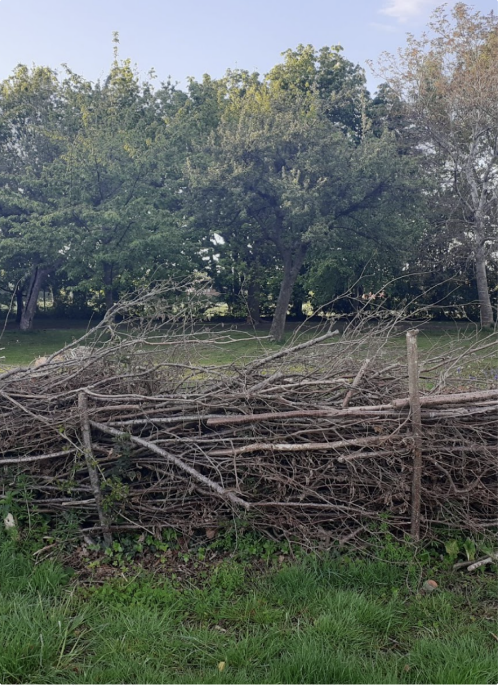Brash
When we lay and coppice hedgerows, we tend to remove a lot of woody material. This is, of course, an essential part of the rejuvenation process, and necessary to get good hedgerow regrowth.
Traditionally, the material removed would be sorted into logs and bundles of brash that would be burned as wood fuel. More recently without such need for wood fuel, it has been more common for this brash to be burned in-field. Whilst this approach is a convenient way to deal with the cuttings, it could be seen as a lost opportunity.
Burning cuttings releases most of the carbon sequestered in the hedgerow back into the atmosphere. Although hedgerows are likely to still be net carbon negative, it could be worth exploring alternative options for the material we remove.
There are a few alternative methods of dealing with this brash to consider, which each suit different farms, hedgelaying scales, incentives and hedgerow types. It might be worth discussing these options with the landowner before work commences.

1) Brash piles. Ask the landowner whether there is a field corner, small woodland or area tucked out the way where the brash can be piled and left to naturally decompose. This will provide fantastic shelter for birds, hedgehogs and other small mammals. As it slowly breaks down, it will increase insect life which will then help feed many other species up the food web, such as slow worms, toads, mice, birds etc. This approach is suitable for all types of hedgerow brash, as long as there is not sign of any tree disease visible.
2) Wood chip. Brash from the hedge can be chipped and used as a mulch for new tree and hedgerow plantings. This can be done on a small scale if you or the landowner owns a chipper, or it can be worth hiring one in for larger extents of laying.
3) Biochar. Made using a similar process to charcoal, biochar is reported to have many benefits. Depending on the efficiency of the burn, biochar can reputedly fix up to 70% of the Carbon from the wood brash into a stable form that does not decompose over time, potentially making it a good way of permanently storing the carbon sequestered in hedgerows. On top of this, it has many practical uses as a soil improver; …………….
Research is on going: University of Nottingham Energy Institute
4) Wood fuel. Particularly when laying large, over stood hedges, you may find a substantial amount of workable wood fuel. Discuss with the landowner before laying whether they have a use for this, or if there is value locally.
5) Protection. The prickly brash removed from a thorn hedge at point of laying can be used to help protect the regrowth from any hedgerows that may have recently been coppiced. With the right amount of brash placed over the coppice stools, light can still reach the stumps to rejuvenate them, but rabbits, hares and deer can’t. As the shoots grow through their prickly protection, the tips may be nibbled, but as long as the animal can’t reach the base of the regrowth, this has the effect of a light trim, and can help bush the hedgerow out.
6) Dead-hedge. Brash can be used to create linear features called dead hedges, where the brash is secured either between posts on either side with stakes driven through the centre of the brash. Whilst these dead hedges don’t provide all the benefits of a living hedge, like brash piles they do create habitat, provide shelter and increased food for wildlife. On top of this, they can improve habitat connectivity if positioned in a way that links up other habitat such as between a living hedge ad a pond, a copse.
Dead hedges can also be used to create a wildlife friendly screen, perhaps screening off a field corner, or used in areas too shady for a living hedge to thrive.
Whilst dead hedges will slowly rot down into the soil from the bottom, they can be topped up each year from any brash cuttings around the farm/estate.
